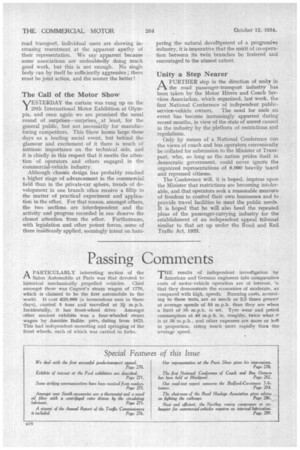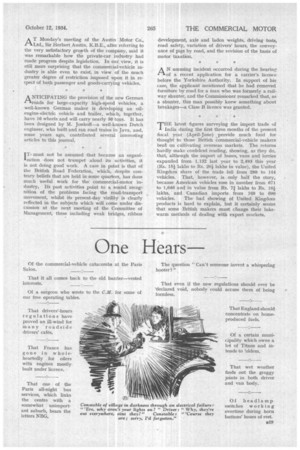Passing Comments
Page 36

Page 37

If you've noticed an error in this article please click here to report it so we can fix it.
A PARTICULARLY interesting section of the 1-1Salon Automobile at Paris was that devoted to historical mechanically propelled vehicles. Chief amongst these was Cugnot's steam wagon of 1770, which is claimed to be the first automobile in the world. It cost .R20,000 (a tremendous sum in those days). carried 5 tons and travelled at 21 m.p.h. Incidentally, it has front-wheel drive. Amongst other ancient exhibits was a four-wheeled steam wagon by Aine'dee BpoHee pere, dating from 1873. This had independent mounting and springing of the front wheels, each of which was carried in forks. THE results of independent investigation by I American and German engineers into comparative costs of motor-vehicle operation are ot interest, In that they demonstrate the economies of moderate, as compared with high, speeds. Running costs, according to these tests, are as much as 3-.5 times greatef at average speeds of 55 m.p.h. than they are when a limit of 35 m.p.h. is set. Tyre wear and petrol consumption at 48 m.p.h. is, roughly, twice what it is at 35 m.p.h., and other expenses are more or in proportion, rising much more rapidly thaa the average speed. AT Monday's meeting of the Austin Motor Co., Ltd., Sir Herbert Austin, K.B.E., after referring to the very satisfactory growth of the company, said it was remarkable how the private-car industry had made progress despite legislation. In our view, it is still more surprising that the commercial-vehicle industry is able even to exist, in view of the much greater degree of restriction imposed upon it in respect of both passenger and goods-carrying vehicles.
ANTICIPATING the provision of the new German
roads for large-capacity high-speed vehicles, a well-known German maker is developing an oilengine-electric vehicle and trailer, which, together, have 16 wheels and will carry nearly 50 tons. It has been designed by M. Jonkoff—a well-known Dutch engineer, who built and ran road trains in Java, and, some years ago, contributed several interesting articles to this journal.
Tmust not be assumed that because an organi zation does not trumpet aloud its activities, it is not doing good work. A case in point is that of the British Road Federation, which, despite contrary beliefs that are held in some quarters, has done much useful work for the commercial-motor industry. Its past activities point to a sound recognition of the problems facing the road-transport movement, whilst its present-day virility is clearly reflected in the subjects which will come under discussion at the next meeting of the Committee of Management, these including weak bridges, ribbon development, axle and laden weights, driving tests, road safety, variation of drivers' hours, the conveyance of pigs by road, and the revision of the basis of motor taxation.
AN amusing incident occurred during the hearing of a recent application for a carrier's licence before the Yorkshire Authority. In support of his case, the applicant mentioned that he had removed furniture by road for a man who was formerly a railway shunter, and the Commissioner remarked that, as a shunter, this man possibly knew something about breakages—a Class B licence was granted.
THE latest figures surveying the import trade of India during the first three months of the present fiscal year (April-June) ,provide much food for thought to those British commercial-vehicle makers bent on cultivating overseas markets. The returns hardly make confident reading, showing, as they do, that, although the import of buses, vans and lorries expanded from 1,132 last year to 2,493 this year (Rs. 151 lakhs to Rs. 26/ lakhs in value), the United Kingdom share of the trade fell from 280 to 144 vehicles. That, however, is only half the story, because American vehicles rose in number from 671 to 1,648 and in value from Rs. 71 lakhs to Rs. 161 lakhs, and Canadian imports from 168 to 696
vehicles. The bad showing of United Kingdom products is hard to explain, but it certainly seems that some British makers must change their lukewarm methods of dealing with export markets.




































































































